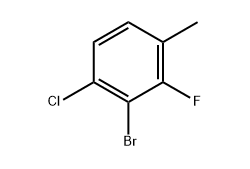How is 2-Bromo-1-chloro-3-fluoro-4-methylbenzene Synthesized?

2-Bromo-1-chloro-3-fluoro-4-methylbenzene is a multi-halogenated aromatic compound that serves as a key intermediate in fine chemical synthesis. It is typically synthesized through selective halogenation reactions of methyl-substituted benzene derivatives.
The process often involves stepwise introduction of halogens such as bromine, chlorine, and fluorine under controlled conditions. Fluorination is usually carried out using reagents like Selectfluor or hydrogen fluoride, while bromination and chlorination steps are achieved through electrophilic substitution on the aromatic ring. Each reaction step must be carefully controlled to ensure high regioselectivity and yield, as the positions of the substituents directly affect the compound’s reactivity in later applications.
Manufacturers specializing in aromatic halogen compounds use advanced synthesis techniques and purification systems to achieve high purity levels (≥98%), ensuring the compound performs reliably in downstream reactions.
Applications in Pharmaceutical Intermediates
One of the most significant applications of 2-Bromo-1-chloro-3-fluoro-4-methylbenzene is in pharmaceutical manufacturing. It serves as a versatile intermediate in the synthesis of active pharmaceutical ingredients (APIs) and complex drug molecules.
The presence of fluorine, bromine, and chlorine atoms enables the compound to undergo diverse substitution, coupling, and cross-linking reactions. Fluorine, in particular, is known to enhance the metabolic stability, lipophilicity, and bioavailability of drug molecules, making fluorinated intermediates essential in modern drug design.
This compound is often used in the preparation of aromatic scaffolds found in anti-inflammatory, anti-cancer, and antiviral agents. Its halogenation pattern allows chemists to fine-tune pharmacological activity by modifying the attached groups during synthesis.
Use in Agrochemical Synthesis
Beyond pharmaceuticals, 2-Bromo-1-chloro-3-fluoro-4-methylbenzene also plays a vital role in agrochemical production. It is commonly used as a starting material for the synthesis of pesticides, herbicides, and fungicides that require halogenated aromatic structures.
The combination of bromine, chlorine, and fluorine in one molecule provides enhanced chemical stability and biological activity. Fluorine-containing compounds are especially valued in crop protection chemistry for their ability to improve persistence and selectivity in the field.
By serving as an intermediate, 2-Bromo-1-chloro-3-fluoro-4-methylbenzene helps agrochemical manufacturers develop products that are more efficient, environmentally stable, and economically viable for large-scale agricultural use.
What Makes It Valuable for Fine Chemical Manufacturing
In the field of fine chemical manufacturing, 2-Bromo-1-chloro-3-fluoro-4-methylbenzene is valued for its multi-reactive functionality. Its structure allows chemists to perform selective transformations—such as Suzuki, Heck, or Sonogashira coupling—enabling the creation of customized halogenated or fluorinated compounds.
This versatility makes it a preferred building block for high-value materials, specialty coatings, and performance polymers. In addition, its balanced reactivity allows for controlled substitution patterns, minimizing unwanted side reactions and improving overall process efficiency.
Producers and researchers rely on this compound for its consistent reactivity, stability, and adaptability, which are crucial traits in precision-oriented chemical synthesis.
Conclusion
2-Bromo-1-chloro-3-fluoro-4-methylbenzene is more than a complex organic molecule—it is a critical intermediate that supports innovation across pharmaceuticals, agrochemicals, and fine chemicals. With its multi-halogenated structure and versatile reactivity, it continues to be an indispensable component in the creation of advanced compounds and new-generation materials.
At our facility, we are committed to supplying high-purity halogenated intermediates that meet strict quality standards, ensuring reliable performance for our global partners in chemical research and production.



